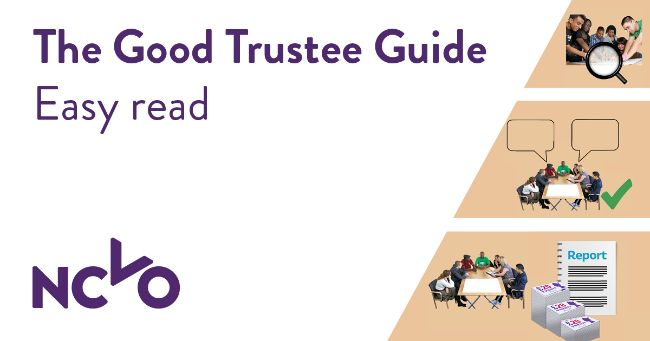
The Good Trustee Guide – Easy Read
What working on the easy-read Trustee Guide taught me about making trusteeship more accessible
Over the past few months we have been working with The Advocacy Project to develop an easy-read version of our Good Trustee Guide. We are really pleased with the finished guide, which provides comprehensive information about a trustee’s role and best practice guidance from voluntary sector support agencies and regulators in a way which is clear and accessible.
The process of developing easy-read versions has been fascinating. Although we have always felt that the Good Trustee guide is clear and jargon free, boiling these complex concepts down into their purest form for the easy-read format has made us think very differently about the information we are trying to present, and we would encourage other organisations to do the same.
We all need to think differently if trusteeship is to have broader appeal
The limited data available on trustees suggests that boards attract people of similar backgrounds and of similar ages. The risk is that this means trustees are also often of similar opinions, resulting in an absence of challenge or scrutiny. The latest draft of the sector’s new good governance code highlights this challenge and emphasises the importance of diverse boards.
If we agree that diversity helps improve decision making then we need to think differently about trusteeship. This includes the way we induct trustees, when and where we hold meetings and how we present information and guidance. It’s not enough to recruit trustees from a diverse background, we need to support them to fulfil their roles.
The Good Trustee Guide is a seminal piece of trustee guidance. It’s widely used by boards and is NCVO’s bestselling publication, but existing guidance is written for existing trustees. Unless we think differently about how we present information and opportunities then we shouldn’t be surprised if we get the same groups of people interested in trusteeship.
Accessibility avoids tokenism
Often those that oppose the diversification, or involvement of service users, on a board, do so on grounds that they worry that their involvement might be seen as tokenistic and that their contribution to the board will not be taken seriously. Board decision making is collective, and it is right boards can only be effective if all trustees are able to contribute to decision making. Yet in the most part, this is the case for working with people to ensure accessibility rather than simply shutting the door for fear of a perceived tokenism.
This is why The Advocacy Project made sure that our easy read text was quality checked by a panel of people with learning disabilities. Their feedback helped shape the final document. Through engagement, and with a commitment to accessibility we can make trusteeship more accessible and ensure that all trustees are able to contribute.
A picture says a thousand words
Developing the easy read version meant stripping back the key responsibilities and concepts from the Good Trustee Guide and really boiling them down. You have to ask yourself, ‘What is it that we are fundamentally trying to say here?’ in order to identify the required amount of text and select clear images to communicate these principles.
The outcome: it is possible to communicate complex information and concepts using very simple language and images without losing the sentiment or meaning.
The world of charity governance is no stranger to jargon. Trustees of all backgrounds get turned off when they are landed with a huge pile of papers to read full of technical language. The approach we have taken to boiling down concepts and ideas to their pure form can be applied to board papers and other communications with trustees.
Where to find the easy read guides
PDFs of the booklets can be downloaded free of charge from the NCVO website. They are called:
- What is a charity
- What is a charity trustee
- What trustees must do
- How trustees look after the charity
This is a guest blog from the National Council for Voluntary Organisations (NCVO). The original post can be accessed on their website here.